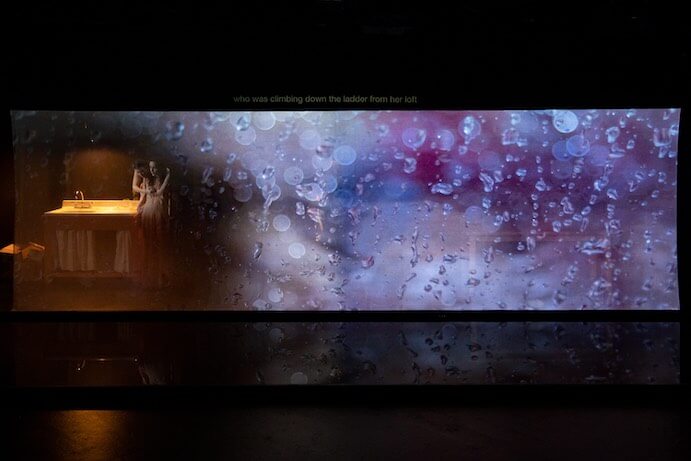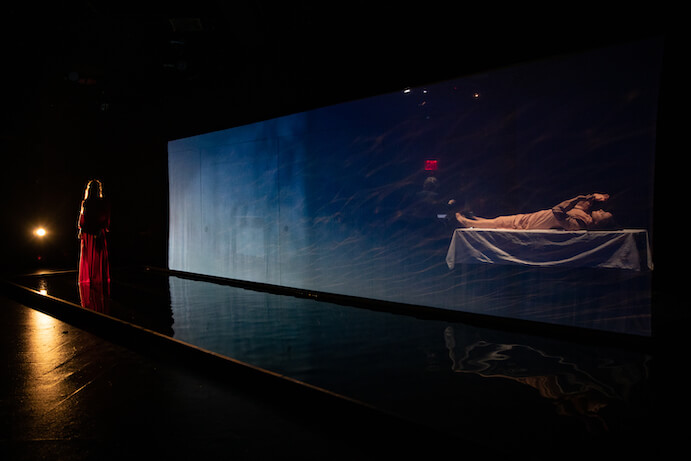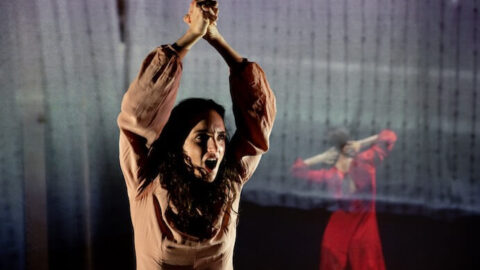Mary Magdalene is famous for her intimate position in Jesus’ inner circle at a time women were not considered equal. She is called the first person to see the resurrected Jesus, and the possibility of their romantic relationship has fueled speculation for centuries. In Western history, she has been a forced receptacle of conflicting and reductionist expectations of women. Co-creators Danielle Birrittella and Zoe Aja Moore took this harlot-virgin archetype of Magdalene as a conduit for the collective female experience and gave both Mary and the universal woman a chance to tell her own story at PROTOTYPE Festival on January 13th, 2020.
To do this, they invited fourteen different women composers to collaborate in setting Maria Howe’s Magdalene poetry: Danielle Birrittella, Ellen Reid, Bergrún Snæbjörnsdóttir, Sheena Birrittella, Christina Courtin, Leila Adu, Kamala Sankaram, Ruby Kato Attwood, Annika Socolofsky, Tanner Porter, Gabrielle Herbst, Gyda Valtysdottir, Molly Joyce, and Emma O’Halloran. Each song presents M., a modern woman grappling with a sense of inner division through mundane moments of life, sex, and angst, and the impressive amalgamation of compositional voices was unified through a shared palette of Desdemona Ensemble string quartet, Sonia Bize on harp, and occasional electronics.
Magdalene is billed as a chamber opera, but the musical setting and use of pre-existing text reverses typical operatic hierarchy and emphasizes the theatrical and visual elements. This structural role reversal mirrored the thematic content just as the interactive chamber music mirrored the collaborative compositional process. The orchestration allowed for unconstrained musical ideas–punchy electronics, harp glissandos, muzak, traditional string quartet writing, and jazz fragments all appeared–but the regulated timbres produced sustained, evocative, and dramatically nuanced music that served to underscore careful choreography and iconic staging.

Division, projection, and transformation were smartly set by Hana Kim on the HERE stage. In front of a dividing scrim was a rectangular pool of water, and behind the scrim was a modern kitchen opposing an unmistakably da Vinci supper table (minus all the disciples and Jesus). Occasional projections graced the screen, and M. navigated shifting divisions of practical and beautiful light. The audience initially projects Mary Magdalene’s dilemma upon M., but they become her captive audience as she stages her own transformation. M.’s conflicted inner life is embodied by singing self (Birritella) and dancing self (Ariana Daub). Both begin clothed in flowing dresses, but Daub quickly sheds her scarlet red costume to move fully nude, introducing vulnerability, eroticism, and disorientation between the dual performers and their audience.
Even at her most exposed, M. is self-possessed. Daub covered herself in light, shadow, water, and extra fabric at whim. More often than not, the M. women are staged apart, foiled by lighting or separated by scrim. Unlike the European art referenced in lengthy, sculptural poses, M. could not be controlled by a voyeuristic gaze. A gaze on one submitted to the other’s freedom, and rarely was the whole woman fully glimpsed. Magdalene is the voice of all those maidens and virgins stepping out of their frames and saying–slowly–Fuck You.
Although Daub’s dance is wordless, M.’s ability to communicate is further loosed by the elevated nonverbal and visual communication. The two struggle to reach one another, mirror their movement, and find different relief in the water. They fight, they literally support one another over obstacles, and they finally unite in compassion in the center of the pool. Through it all, the atmospheric score paced precisely by conductor Mila Henry contextualizes M.’s journey and gives her another language to master and wield.

The finale was a notably disappointing example of good intentions gone awry. Meant to be an inspiring list of universal womanhood, M.’s literal identification with an array of women throughout history and the world was a heavy-handed overstatement that included an embarrassing dramatic imitation of a woman with Alzheimer’s. It was especially odd compared to the standout song “Their Bodies” by Tanner Porter that gave the middle finger to female objectification by cataloguing a list of penis personalities in catchy music, sharp humor, and emotional breadth that turned on a dime. The general orchestration rarely reached extreme registers and could benefit from stronger momentum, and Magdalene also needs to find a singer equal to its vocal demands. Still, the show is impressively fresh and adaptable for a production that is rooted so deeply in white Western art and religious history. It is open for diverse future interpretations, and would be fascinating to see transposed into other vocal styles, radically different cultures, and multi-generational casting of the dual M.
It is a great irony that Mary Magdalene is unable to escape male expectations even in 2020. Our rightfully heightened sensitivity to women’s sexual rights and #MeToo complicates the critical situation; nonetheless, responses to this work seem to focus on an overly gendered and politicized creative process at the expense of what is profound. Magdalene’s merit is not how snazzy the girls can be when they all get together. Rather, a group of professionals focused their skill on repositioning a canonical problem, and they fearlessly repurposed tradition and wield their own bodies in a charged and masterful way. Perhaps most courageously of all, Magdalene is unabashed in its use and celebration of beauty. This exploited currency and abstract contraption so often used against women is never surrendered; it is joyfully reclaimed and that proper ownership enriches us all.
























